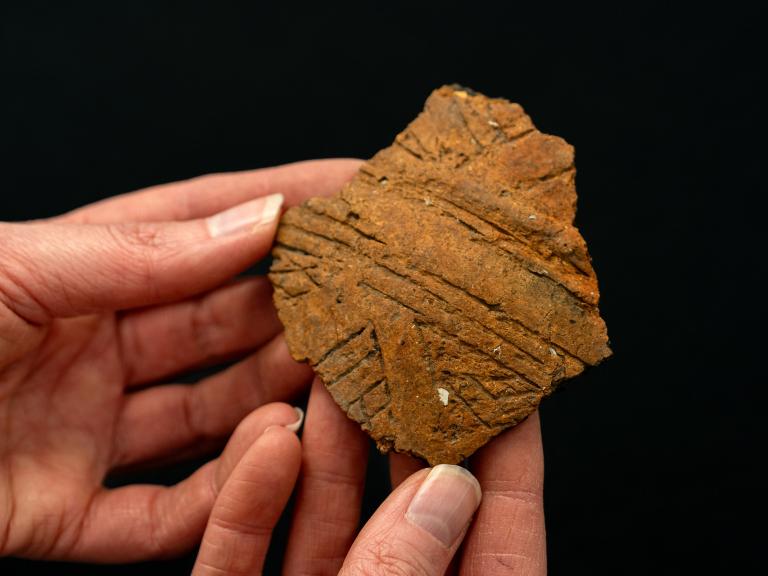Archaeologists undertaking preliminary evaluations across the planned A303 Amesbury to Berwick Down Scheme sites have revealed Neolithic burials, a Bronze Age ’C’-shaped enclosure and ancient tools and pottery.
Wessex Archaeology’s investigations uncovered evidence of human activity dating back over 7000 years. Evaluation work has been unprecedented in recognition of the significance of the World Heritage Site. The work has been monitored on site by Wiltshire Council Archaeology Service and other members of the A303 Heritage Monitoring and Advisory Group.
The scale of the evaluation works includes:
- 462 ha of new gradiometer survey of the scheme corridor in four phases
- 23 ha of targeted ground penetrating radar survey
- 20 ha of multichannel ground penetrating radar survey (western portal approach)
- 1,777 topsoil test pits hand-excavated and sieved
- 440 trial trenches excavated and recorded
A small object made of shale – found in the grave of a female in her twenties or early thirties – has intrigued archaeologists. The burial dates to the Beaker period, around 4,500 years ago, when new types of pottery and other objects appear in Britain. This period also saw the building of some of the bluestone circles at Stonehenge.
Dr Matt Leivers, A303 Consultant Archaeologist at Wessex Archaeology, says:
“It’s a unique object: we have never seen one before. Although not hugely significant, we can only speculate about what it was – it may have been a ceremonial cup purposefully damaged before it was laid in the grave, or it may be the cap off the end of a staff or club.”

Nearby pits from the same period were found to contain other traces of human activity, including fragments of pottery, worked flint for tools, and animal bones. Archaeologists also also discovered tiny ear bones from a young infant in one of the pits, buried alongside a plain Beaker.
Elsewhere, a ‘C’-shaped enclosure dating to the late Bronze Age is thought to have been an area for industrial working, due to the density of burned flint contained in the soil around it.
“These preliminary investigations have offered us the opportunity to understand more about this landscape, and delve into the lives of those that have lived within it over thousands of years,” explains Matt. “What we’ve found are some small traces and intimate details of these people. It’s not going to change our understanding of this place, but it can help us add detail and build on the picture we already have.”
The investigations have informed the main archaeological fieldwork, due to begin on site in late spring this year. The main phase of fieldwork will involve around 100-150 archaeologists and last approximately 18 months ahead of construction starting on site in 2023.
Andy Crockett, A303 Project Director at Wessex Archaeology says:
“We’ve done a huge amount of initial work which has been extremely thorough – more so than any site I’ve worked on in my 40-year career – reflecting the sensitivity of this site. We now have a very clear idea of what we expect to find in the upcoming main fieldworks. Everything we find will be processed, conserved and analysed by the specialists in our Research department. We’ll also be drawing on the expertise of our partners in the archaeological sector, so that we make sure that the best possible outcomes are achieved for the archaeology.”
Ultimately, all finds will be delivered to Salisbury Museum to be displayed to the public.
David Bullock, A303 Project Manager, Highways England, says:
“It is a scheme objective to conserve and enhance the World Heritage Site and this is being achieved through close collaborative working with heritage groups, the independent A303 Scientific Committee, and our archaeology contractors Wessex Archaeology, who have an extensive track record of work in connection with the Stonehenge landscape.
“The route itself has been designed to ensure there are no direct impacts on scheduled monuments and the amount of archaeological survey and mitigation work is unprecedented because, in recognition of the significance of the WHS, the surveys are over and above what would have usually been done at this stage of a highway project.
“As part of the extensive archaeological surveys to date, we have uncovered some interesting but not unexpected finds, and we are now preparing plans with Wessex to start further archaeological excavation work later this year. This will be monitored on site by Wiltshire Council Archaeology Service, and members of the independent A303 Scientific Committee and A303 Heritage Monitoring and Advisory Group.”
